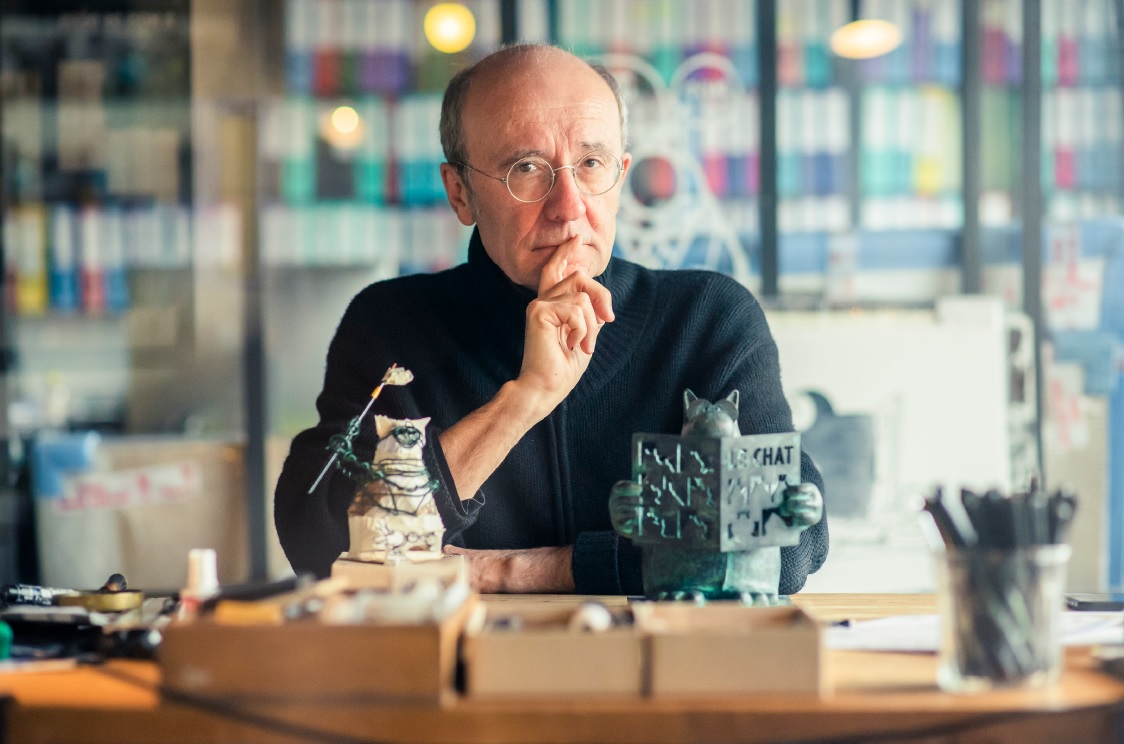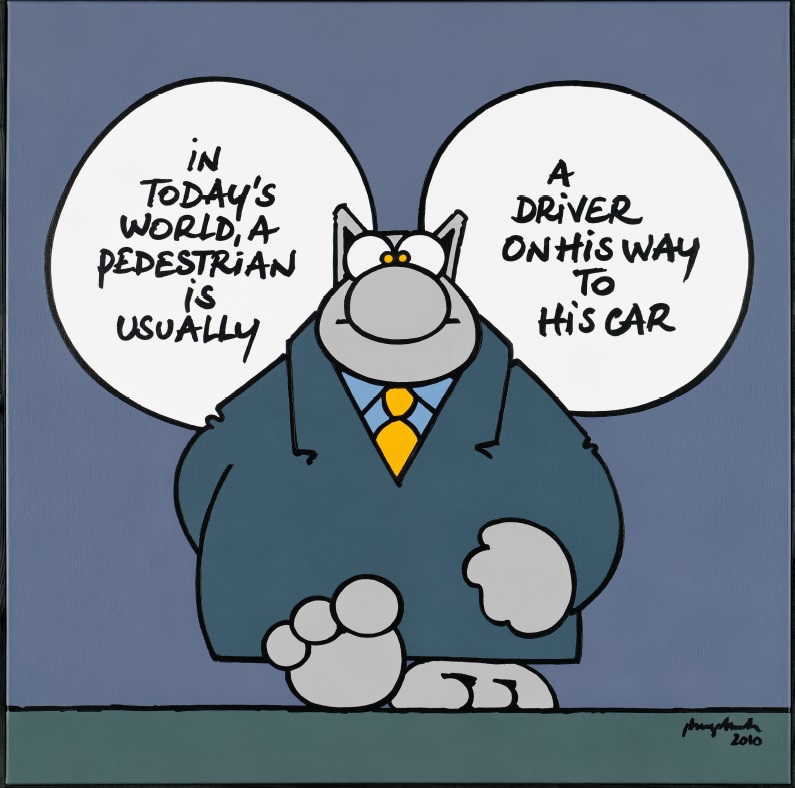Philippe Geluck, or simply Geluck as he is known in France or Belgium, is a one-man band of creativity and humour. He works as an artist, sculptor, illustrator, writer, actor, and TV and radio presenter. Also billed as the French-speaking world’s most popular and successful cartoonist, he even did stand-up comedy for a short period ten years ago.
He lists art as the favourite of his six or seven jobs, but adds, “I have loved everything that I have done,” he tells me in his Ixelles office awash with Le Chat art. We are drinking our coffee from Le Chat cups and the eponymous feline stares at me from a poster, proclaiming, “This painting is perhaps expensive, but looking at it costs nothing.”
Geluck’s sardonic, deadpan Le Chat images adorn everything from museum walls and mugs to Dolfin chocolate bar wrappers and Galler ‘langue de chat’ biscuit tins.
He is also seen in street art. On the Chaussée de Wavre, Le Chat invites tourists to consider his mural as important as the Atomium. Another 12-metre-high mural adorns the playground at the primary school named after him in Herseaux (Mouscron). Other honours include a square baptised Square du Chat in Hotton, Luxembourg province.
Now he is celebrated in his home town: an exhibition of bronze Le Chat sculptures runs in Brussels Park (Parc de Bruxelles/Warandepark) from March 9 until July.
Le Chat is now almost a Belgian institution. First appearing in Le Soir on March 22, 1983, Le Chat became the daily newspaper’s mascot. It was also used to illustrate articles – and in doing so, attracted more readers, and winning over any author who had perhaps not wanted Le Chat on their work to start with, Geluck said.
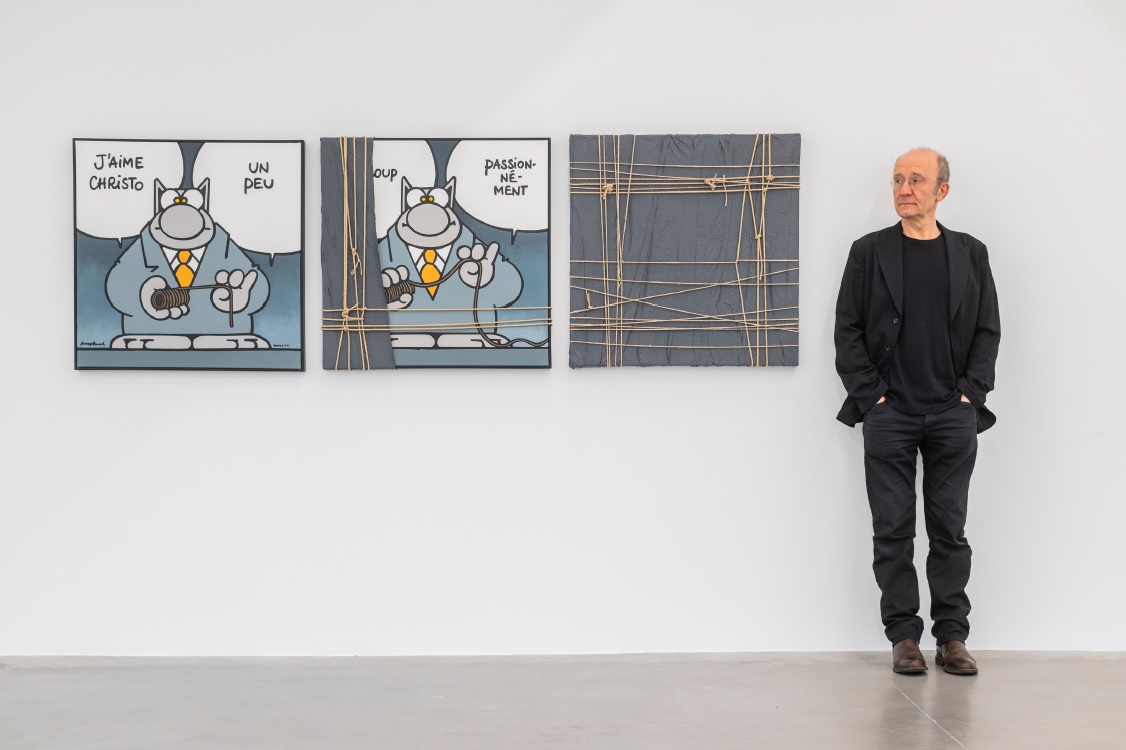
Geluck at an exhibition of his images
After 30 years, Geluck left Le Soir to concentrate on other projects – most notably his exhibitions. His sculpture shows started on the Champs-Elysées in Paris before moving to Bordeaux, Caen, Geneva and Monaco. “I often leave projects before they became too routine with enormous constraints,” Geluck says. “Now I have a lot of liberty.”
Etterbeek artists
Geluck was born in Etterbeek in 1954 into a family of art and culture lovers. His father, an illustrator, adored showing him artists like Rembrandt, Goya and Vermeer, as well as cartoonists like Sempé and Siné. His mother, a would-be historian and soprano “who sang Mozart and Beethoven all day long,” took him to museums on Wednesday afternoons like the Cinquantenaire at the top of his street and the Science Museum at the bottom. “I came from a real triangle of artists,” Geluck says, noting that both Tintin creator Hergé and André Franquin, author of Spirou and Gaston, were born in Etterbeek.

Geluck in his studio
While Brussels-based for most of his life, Geluck always wanted Le Chat to be universal. “The cat cartoons are not specifically Belgian, and do not feature Belgium, apart from a few pictures of the Atomium perhaps,” he says. “But their DNA is clearly anchored in this culture of pictures of Hergé or Magritte. If I were born in Lisbon or Paris, the drawings would not have been Le Chat, or have had the same philosophy and sense of absurdity, but also with this decent, caring side.”
The style is often satirical or ironic, but Geluck avoids scorn or derision. “I can do drawings that may seem cruel, but they are not in bad taste and people understand they are to make them laugh,” he says. He’s reluctant to name his favourite, but singles out the Le Chat drawing on a Brussels map captioned “News travels fast”.
Theatre and family
Geluck’s main love remains drawing and painting. But he had an exceptionally varied career. A year after graduating from Saint-Gilles’ film and drama school Institut National Supérieur des Arts du Spectacle et des Techniques de Diffusion (INSAS) in 1976, he founded the Théâtre Hypocrite and acted in major Belgian venues for ten years.
From 1979 to 2006, he created, presented or took part in thousands of television and radio shows on the Belgian radio and TV network RTBF, France 2, Europe 1 or RTL, working with people including presenters Michel Drucker and Laurent Ruquier.
Many Belgians first encountered him on bitingly witty Lollipop, which ran from 1980 until 1985 and was billed a children’s programme that whole families could watch. But he insists acting was “perhaps an error in my creative path, I am not the best.” That said, he performed in numerous high-profile plays including Brecht’s Threepenny Opera at the National Theatre Brussels and Chaval’s Les Gros Chiens.
Humour is a constant in Geluck’s career. “I wanted to do television and radio as I always did humour,” he says. “I was not a classic presenter. I preferred to do sketches. But if I lost my hands and could not draw, I would continue in radio.”
Family is essential too. He has a son, daughter and four grandchildren from his 46-year marriage, which he describes as “the most beautiful adventure of all.” He met scriptwriter Dany, the “love-of-his-life”, in 1976, on the set of a short film, Le coq mouillé. “It was a real coup de foudre and our life together began 48 hours later.”
Creating the cat
Dany takes centre stage in the very first Le Chat drawing, illustrating their 1980 wedding present thank-you card. With Madame on one side and Monsieur the other, opening it reveals them enjoying a typical honeymoon activity, “shocking the grannies and making everyone laugh.” Three years later, when son Antoine was born, he was featured with the couple on the birth announcement.
But why a cat and not a dog? “We tried rabbits and it was a bit cliché and dogs looked a little ugly, but we thought cats looked like us,” Geluck explains, adding that he is a cat lover himself. “Le Chat in his suit is perhaps my double and cats like me a lot too. They come to me at friends’ houses when they ignore other people, when there is no real reason for it,” he says.
When a Le Soir journalist asked Geluck to produce a cartoon three years later, he remembered those wedding card drawings. Le Chat was born, with the first comic strip published on March 22, 1983. Thus began Le Chat’s phenomenal success, not only in the Le Soir, but also in the first album in 1986 that sold out three print runs, and through exhibitions all over Europe. The 2003 itinerant exhibition “Le Chat s’expose” attracted more than 350,000 visitors in Paris, Brussels (Autoworld), Bordeaux, Rennes and Charité-sur-Loire.
Le Chat now has a global profile. “It has been translated into 16 or 17 languages, even Chinese, and reaches audiences as far away as the United States and Canada,” Geluck says.
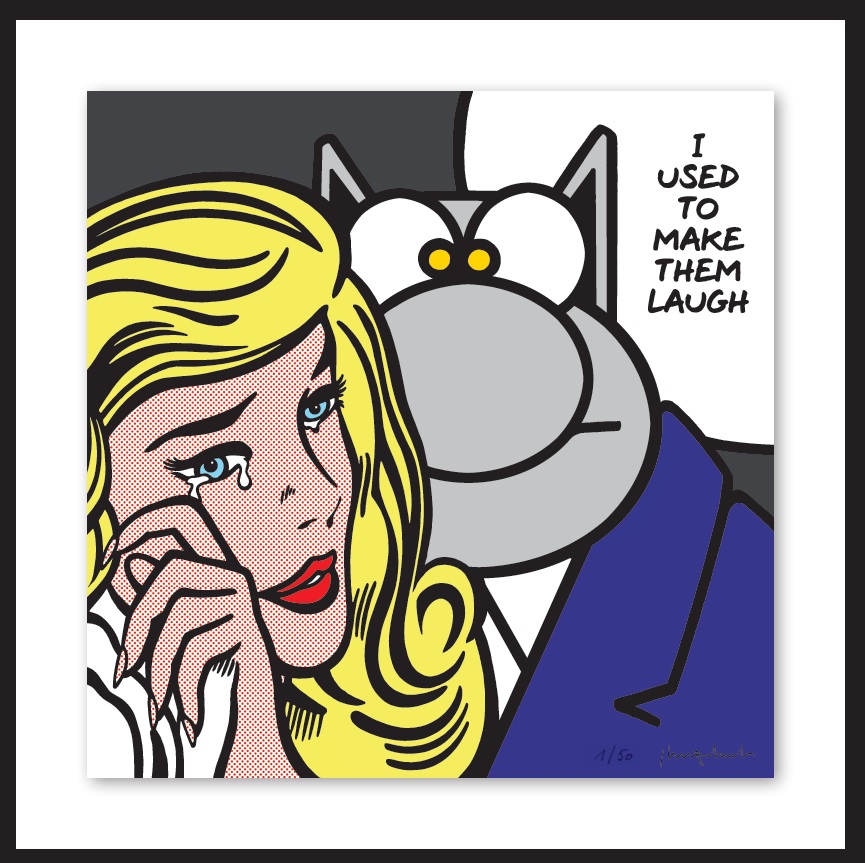
Le Chat and Roy Liechtenstein
Another key milestone was 2016’s “L’Art et Le Chat”, a book using Le Chat to entice children (and a few adults) to appreciate the world’s great art from Leonardo da Vinci’s Mona Lisa and Rodin’s Le Penseur to lesser-known artists like Verena Nusz and Pierre Soulages. For example, one drawing proclaims: “This is perhaps a false Soulages, but that does not stop it being hung in a real Geluck.”
Two years later came Geluck’s take on Banksy’s ‘shredder art’. In 2018, just moments after the English street artist’s painting was sold for €1.3 million at Sotheby’s, it rolled into a built-in shredder hidden in the frame (in 2021, the same shredded work sold for €26 million).
In Geluck’s version, presented at the October 2018 Brussels Art Fair (BRAFA), Le Chat holds a red balloon and asks, “Has art become too commercial?” Then, like Banksy’s, it goes down into its frame and “turns into shredded strips,” but comes up again whole before people’s eyes: “It was the most filmed piece in BRAFA that year and sold immediately,” Geluck says proudly.
Clay claws
Meanwhile, sculpture, something Geluck had only dabbled in when still at school, came almost by chance, after sculptor François Deboucq visited the Le Soir offices in 1987 to show him a model of Le Chat.
After Geluck said it was excellent but did not quite capture Le Chat, he was given 5kg of clay and challenged to make a bust himself. The result impressed Deboucq, who exclaimed, “You’re a sculptor! I have never seen anybody capable of creating a work of that quality in 20 minutes.”
They have worked together since then, their first big event being the Champs Elysées show with 20 Le Chat sculptures including The Doctor (laughter heals), The Birdy Builder, Romeo and Juliet and Getting your own Back (when a car is run over by Le Chat).
Geluck, who has also produced Le Chat albums for children, emphasises that sculpture, with no words, is special as, “it speaks to everyone and all generations, from kids three years old who came and hugged the sculptures on the Champs Elysées to their grandparents.” Seven million saw his exhibition, despite the ongoing COVID pandemic at the time.
Geluck now spends a third of his time sculpting, a third painting and a third drawing. Some 23 albums have been printed by Casterman since 1986, with 14 million sold. He uses comic strip codes, but Le Chat is not a classic bande dessinée in the Franco-Belgian sense of the term, he explains, saying he is close to the work of cartoonists like Gary Larson, the creator of The Far Side.
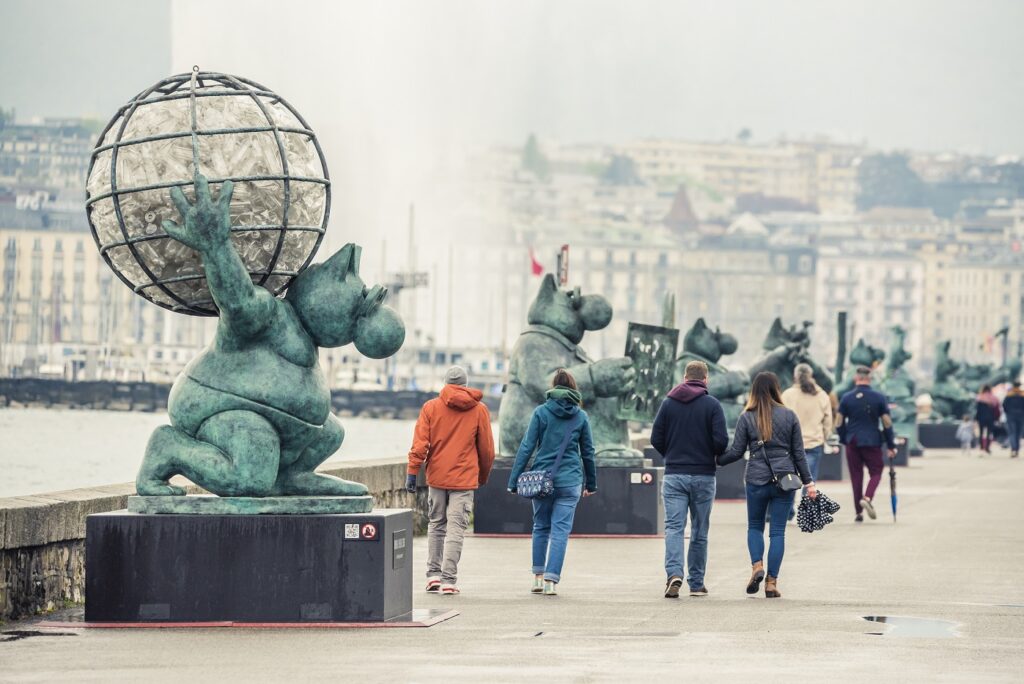
The sculptures on show in Geneva
Art is a vital driver: Geluck says he goes to museums in every city he visits. His particular favourites are Rembrandt, Goya, Hopper and Magritte, but also Soulages, Basquiat, Tomi Ungerer and Saul Steinberg. “I endorse what Anton Chekhov said. I divide all works of art into two categories: those I like and those I do not like. I have no other criteria,” he says. Art, he says, should produce an emotion: a laugh, a smile, a tear. “You can detest a painting, but this is still a reaction.”
Geluck’s first exhibition, in 1974, was of watercolours influenced by the likes of Ungerer, Steinberg and Folon. Cats were nowhere to be seen. It was not until 1991 that Le Chat made its first big appearance at a gallery, at Van de Weghe in Brussels: he presented a three by two-metre canvas of Le Chat announcing: “Laughter is unique to man, and so is soap.”
In his office, he has an “Aid for the carers,” poster with mask-wearing cats. Geluck helps many charity campaigns with Le Chat posters. “I do around 40 a year including support to Iranian women, children suffering from cancer, the homeless, anti-war posters,” he says.
But Geluck insists, “Le Chat must remain light and humorous, even if the subject is serious and he is denouncing injustice and calamitous things.” Indeed, Le Chat himself says, “My job consists in making gags about the world’s main problems to amuse my compatriots.”
Fur family
Le Chat’s DNA is to make people laugh and bring happiness, Geluck says. “Laughing is a form of happiness. A baby will smile and laugh before talking. So if I can make humorous drawings and make people laugh, it is mission accomplished.”
But his biggest challenge is to continue, keeping everything new while entertaining his fans. His 24th album is planned for October. He does have critics, albeit few. “You cannot please everyone,” he says. “It is like the comedian saying there are 2,000 people in the theatre, but I only see the one who does not laugh.” Geluck does not read comments or criticisms on social media, figuring, “If I don’t read it, it does not exist.”
Geluck’s creative energy is currently channelled into the Brussels Park exhibition. It will comprise the 20 that graced the Champs Elysees, along with two new ones. In parallel, the Huberty & Breyne gallery in Ixelles will showcase Le Chat pictures from March 9 to May 9, some of which have never been seen before.
For now, Geluck has turned down the proposal of a North American tour. Instead, he wants to concentrate on the planned Le Chat museum, which would be funded by sculpture sales as well as sponsorship. It is set to be based between the Place Royale and Bozar. “The museum will take up much of my time,” he says. The building will start soon, with the empty shell due to be delivered at the end of 2024 and the inauguration scheduled for 2026.
Amid these plans, Geluck tries to stay grounded. “It would be mad to try and do too many shows and travel when I have so much to do here and see my family,” he says. “Every day, I come downstairs and work from 9am to 7pm. But then I go upstairs and become a civilian again. Life has to be the priority.”

